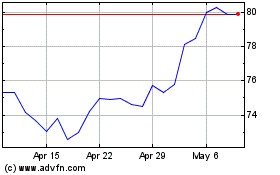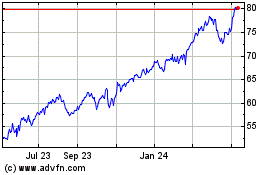Some directors feared a potential fight with billionaire if CEO
Hancock stayed
By Joann S. Lublin and Leslie Scism
The person at the center of last week's surprise change atop
insurance giant American International Group Inc. wasn't Peter
Hancock. It was activist investor Carl Icahn.
The 58-year-old Mr. Hancock agreed to resign as chief executive
after several directors met with him Wednesday evening in his AIG
office in downtown Manhattan, according to people familiar with the
matter. Some directors at the time were worried about the CEO's
ability to continue improving the company's results, while several
also feared a potential fight with Mr. Icahn.
The huddle followed a private session of the company's
independent directors in which they had discussed Mr. Hancock's
successes and shortcomings, adding new detail to last week's sudden
shake-up at AIG.
That "executive session" occurred after a two-day board meeting,
during which Mr. Hancock and his team highlighted accomplishments
in trying to bring AIG's results in line with the best of its
peers. Mr. Hancock has agreed to stay on until a successor is
found.
Last month, AIG posted one of its worst quarterly results since
the financial crisis, with major setbacks in the global insurance
firm's turnaround plan. The AIG directors feared disruption if they
didn't quickly address concerns from Mr. Icahn and some directors
about the CEO's ability to complete the turnaround, people familiar
with the matter said.
So they pushed for Mr. Hancock to step aside, the people
said.
A decision "to stand by [Mr. Hancock] would carry the threat if
not the reality of a battle with Carl," said a person familiar with
the matter.
Despite the coming change atop AIG, the board remains committed
to the current turnaround plan developed by Mr. Hancock and won't
consider "breaking up the company," AIG Chairman Douglas Steenland
said in taped comments to employees Monday night. He said AIG
previously rejected such a breakup plan, which Mr. Icahn proposed
in 2015.
In his taped comments Monday night, Mr. Steenland also said
directors have begun their search for AIG's next chief executive
and likely will pick an outsider. "We are highly focused on the
search to bring in the right person to lead the company at this
important time," he added. "
Mr. Icahn, who disclosed a stake in AIG in fall 2015, had called
for Mr. Hancock's firing before reaching an agreement in early 2016
for a board seat for an Icahn representative. Fellow billionaire
investor John Paulson also obtained a board seat.
Waging a campaign against an activist is typically distracting
for management. For a financial firm like AIG, such fights can be
tricky as managers try to maintain the confidence of ratings
companies and customers. The uncertainty of potential change in the
company's strategy can slow new business.
The next CEO at AIG will be the firm's seventh since 2005, when
a period of turmoil began. In 2008, AIG nearly collapsed and
required one of the biggest bailouts of the financial crisis, at
nearly $185 billion. AIG fully repaid taxpayers by the end of 2012
by selling almost half of its assets and began to focus on
improving results in the remaining businesses.
Mr. Hancock said in a memo to employees last week that he was
leaving because, "without wholehearted shareholder support for my
continued leadership, a protracted period of uncertainty could
undermine" turnaround efforts. Mr. Icahn said last week he
supported the board's actions.
Mr. Hancock appeared to be making headway in improving results,
but AIG shares fell 9% on the Feb. 14 disclosure of a $3.04 billion
fourth-quarter loss and additional bad news the next day: lowered
targets for improving two closely watched profit measures.
The results included a $5.6 billion boost to claim reserves.
Some of the charge applied to policies sold during the financial
crisis, when rival executives have said AIG undercut them on prices
to keep revenue flowing.
More alarming to some analysts and investors, the charge also
applied to policies sold from 2011 through 2015. Mr. Hancock
directed the property-casualty unit from 2011 to 2014 and became
CEO in 2014.
At last week's board meeting, Mr. Hancock explained how his team
had reduced the risk of additional reserve charges by signing a
reinsurance agreement in January with Berkshire Hathaway Inc. In
addition, the company has dramatically reduced its exposure to some
types of liability insurance sold to U.S. businesses such as
trucking firms, while also sharply reducing expenses, among other
steps.
Some AIG board members found management's presentation
compelling. "Peter and his team were doing a good job," one person
said.
Still, the independent directors leaned toward his departure
during their executive session, the people said. Such sessions
exclude the CEO and other members of management.
Mr. Steenland and several other directors then summarized the
sentiments to Mr. Hancock in his 30th-floor corner office
overlooking the East River, the people said.
Mr. Hancock told the group he should step down "if he does not
have the unwavering full support of the entire board," according to
a person familiar with the matter.
As part of the transition process, AIG has hired a
executive-search firm to help it look for a new CEO, a person
said.
Write to Joann S. Lublin at joann.lublin@wsj.com and Leslie
Scism at leslie.scism@wsj.com
(END) Dow Jones Newswires
March 15, 2017 02:47 ET (06:47 GMT)
Copyright (c) 2017 Dow Jones & Company, Inc.
American (NYSE:AIG)
Historical Stock Chart
From Mar 2024 to Apr 2024

American (NYSE:AIG)
Historical Stock Chart
From Apr 2023 to Apr 2024
